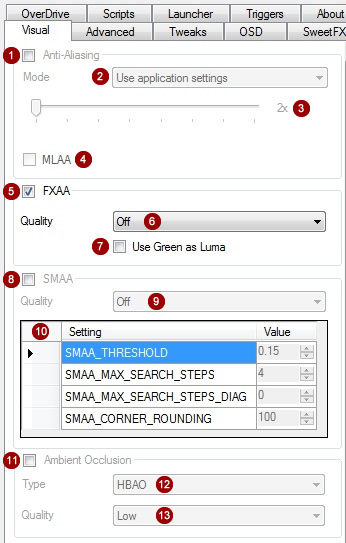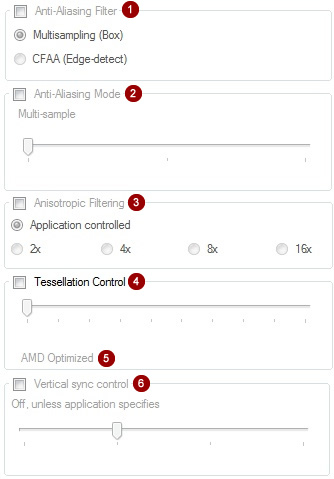
The Visual tab groups the most common settings related to image quality, which includes Anti-Aliasing level, Anti-Aliasing filter, Anti-Aliasing mode, Anisotropic Filtering and Vertical Synchronization control (also known as VSync). Recent Catalyst versions introduced a new Anti-Aliasing technique, called Morphological Filtering or MLAA, that can be used on HD 5000 and newer series.
Anti-Aliasing level
Anti-Aliasing level, or just AA, determines the number of samples to be used for locating image jaggies, higher levels mean high quality image but higher GPU resource usage as well. Anti-Aliasing can be also controlled by the application, meaning you have to set the AA level inside your game’s options. This is the preferred setting if your game has in-game AA configuration. If your game lacks AA control, you can try setting the wanted level of AA here and see if it works.
Enhanced Anti-Aliasing Quality
EQAA for short, this Anti-Aliasing enhancement works by storing color samples on GPU Render-Back Ends that are used to further enhance the final Anti-Antialiasing quality. EQAA is a feature found only on newest HD 6900 series and it’s not supported on previous hardware families due to lack of hardware support on older GPUs.
With EQAA introduction, Anti-Aliasing level can now be either Application controlled, Enhance application settings or Override application settings. The first option is the well known option that leaves the Anti-Aliasing responsibility to the game engine, which in turn tells the API where AA should be applied and the number of samples/quality of AA should be used. The second is the new option that still leaves the AA duties to the game engine, but use the game engine defined number of samples and enhance it. Let’s say you have AA 4x set on your game, by using Enhance application settings the driver will apply 4xQ level to the image. The last option, Override application settings, ignores the game engine AA level and leaves to the driver the AA processing. This is the last option for a reason, as you should always use the game AA settings whenever possible. Overriding application settings for AA doesn’t work for every game because the driver recognize the engine.
MLAA (4)
Morphological Filtering, or MLAA, is a new type of Anti-Aliasing introduced since HD 6800 series launch, but is supported on any DirectX 11 class video card from AMD. AMD’s MLAA implementation works behind the scenes removing the jaggies from the entire image using advanced techniques based on DirectCompute 11, a standard Direct3D 11 API feature.
It’s easy to see when MLAA is working, see the contour of FPS numbers below:


On left you see the FPS number without MLAA, and on the right the FPS number with MLAA active. When you take screenshots using standard utilities you will notice that the FPS number stays as if it doesn’t have MLAA, and in fact the whole screenshot doesn’t have MLAA applied.
FXAA (5)
Fast approXimate Anti-Aliasing or FXAA is a post-processing anti-aliasing technique created to be fast and versatile while having a small memory footprint and high performance. Learn more about FXAA on RadeonPro Features page.
FXAA quality (6) can be set at Off, Low, Medium, High and Ultra. RadeonPro can’t apply FXAA in some games (mostly DX9 games) due to its internals, if you are trying to use FXAA but can’t get it working, try setting option “Use Green as Luma (7)” to see if it works.
SMAA (8)
Sub-pixel Morphological Anti-Aliasing or SMAA is another post-processing approach to anti-aliasing. SMAA combines techniques used by Morphological Anti-Aliasing (MLAA) with other common techniques like MSAA/SSAA to remove jaggies while preserving image sharpness. Learn more about SMAA on RadeonPro Features page.
SMAA quality (9) can be set at Off, Low, Medium, High, Ultra and Custom. When Custom quality level is set, the Custom SMAA variables can be changed right after (10) the quality combo box.
Ambient Occlusion (11)
Screen Space Ambient Occlusion (SSAO) or just Ambient Occlusion is a rendering technique for efficiently approximating the well-known computer graphics ambient occlusion effect in real time. Learn more about Ambient Occlusion on RadeonPro Features page.
Ambient Occlusion type (12) can be set at HBAO (Horizon Based Ambient Occlusion) and Volumetric Ambient Occlusion. Click here to learn more about Ambient Occlusion types.
Ambient Occlusion quality (13) can be set at Low, Medium, High and Ultra. At Low, Medium and High levels the ambient occlusion is calculated using half-frame, which gives better performance and good quality. Ultra level uses full-frame hence resulting in better quality but with higher performance hit.
Not all games support Ambient Occlusion. The supported games list can be found on RadeonPro settings at Ambient Occlusion section.
In order to use Ambient Occlusion feature you must activate the option in RadeonPro Settings/Ambient Occlusion section and must turn the feature on at profile level.
Anti-Aliasing filter
Anti-Aliasing filter is a hardware feature introduced since HD 2000 series launch, it can be the standard Box filter shared by IHVs, and can be also one of the custom filters provided by the driver. Currently, all series support Narrow-tent, Wide-tent and Edge-detect filters with exception of HD 6000 series, which dropped Narrow-tent and Wide-tent filters, supporting only the former Box filter and the best quality Edge-detect filter.
The filter type determines the overall image quality, the Box filter is the standard which delivers good quality and performance. The Narrow-tent and Wide-tent filters tend to blur the polygon edges too much, making the overall image too blurry, but some games may look better with those filters. And finally the Edge-detect filter, this one uses very advanced algorithms to produce the best image quality, but with a high utilization of GPU resources.
Anti-Aliasing mode
Anti-Aliasing mode determines how transparent textures are going to be anti-aliased by the driver. The modes depend on the graphics card series, until HD 5000 they can Performance and Quality. On HD 5000 and newer series it can be Multi-sample AA, Adaptive Multi-sample AA and Super-sample AA.
Anisotropic Filtering
Anisotropic Filtering, or just AF, can be either controlled by the game or can be a value you choose. If your game has AF configuration in-game you should prefer it instead of forcing AF in the driver. If the game lacks AF control you can set a value here to improve image quality. The performance hit is small so you can experiment with 8x or 16x without degrading performance too much while improving image quality a lot.
Tessellation Control
Tessellation Control allows for fine tuning of Tessellation levels used by games/applications. Some games might use exaggerated levels of Tessellation that turns out to be overkill in a performance vs quality balance, in those cases Tessellation level can be set to a lower level resulting in better performance with little to none quality change.
AMD Optimized
AMD Optimized leaves to the driver the selection of best tessellation level depending on game/application being executed.
Vertical Synchronization control
Vertical Synchronization, or just vsync control determines if the driver should present the image framebuffer synchronized with monitor refresh rate to avoid screen tearing, common on flat display monitors. Vsync on offers the best quality, but can degrade performance on less powered GPUs or when the game doesn’t supports Triple-buffering. You can force triple-buffering on any OpenGL application through the driver, but Direct3D games can’t be forced by the driver to use triple-buffering. RadeonPro comes to the rescue by allowing triple-buffering utilization on almost all Direct3D games, with rare exceptions. You will learn more about forced triple-buffering as you advanced through the topics.


Pingback: Kurze Frage zu Downsampling